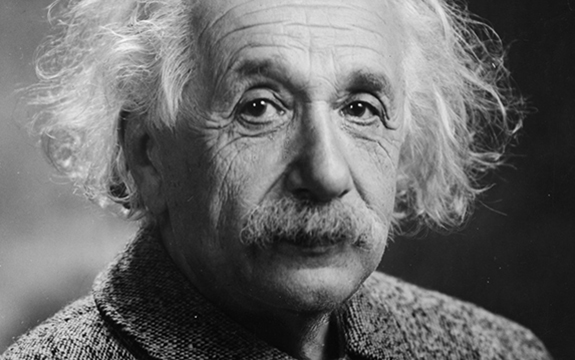Einstein's folly: how the search for a unified theory stumped him to his dying day

In Summary
- Analysis for The Conversation by Glen Mackie, Senior Lecturer in Astronomy and Astrophysics, Coordinator of Swinburne Astronomy Online, Swinburne University of Technology.
This month marks exactly 100 years since Albert Einstein submitted the first paper fully describing the general theory of relativity. It was both breathtaking and revolutionary.
Simply stated, gravity is a geometric property of spacetime that is allowed to be curved. It was like looking at Newton’s world through the bottom of a glass.
General relativity is based on Einstein’s field equations, which describe the relation between the geometry of a four-dimensional description of spacetime, and the energy–momentum contained in that spacetime.
Spacetime curvature is caused by mass; the more mass, the more spacetime is curved. This curvature can induce deflections or delays in the propagation of light.
Even close to home, our sun – not that massive as stars go – will alter the path of light near it. Newton’s theory predicts a deflection of light of 0.875 seconds of arc at the limb of the sun, whilst relativity predicted a deflection of 1.75 seconds of arc. Observations during total solar eclipses of background star fields confirmed Einsteins value.
Even had Einstein died shortly after his work on general relativity, he would still be regarded by many today as the greatest physicist who ever lived, and perhaps even the greatest scientist.
Towards a unified field theory
However, whilst he continued to work on many problems up until his death in 1955, he is regularly described as failing in one particular area: the unified field theory.
From the 1920s, Einstein tried to develop a unified theory that melded general relativity and electromagnetism, representing the only two forces known to exist.
Such a theory would describe a single field in which all forces are mediated and the properties of all particles – which at the time were only electrons and protons, with the neutron not discovered until 1932 – could be deduced.
Other players in the quest appeared. Theodor Kaluza showed that if spacetime had five dimensions, then four dimensions could reflect general relativity, and one could represent electromagnetism. In the burgeoning quantum world of the mid-1920s, Oskar Klein shrank Kaluza’s 5th dimension to be compact, in a sense offering a quantum mechanical interpretation.
Einstein drew upon other work if it could help his cause. He even looked at variations to the successful mathematical basis of general relativity. It is widely reported that he did not support quantum mechanics, but promoted it (suffered it?) being a derivative of an eventual unified theory.
Strong developments
In a way, his mathematical focus hindered his acceptance of ongoing, major discoveries in physics like quantum mechanics. The discovery of two new forces in addition to gravity and electromagnetism – the strong and weak nuclear forces – also made his work of a unified field based only on two forces unattainable.
Protons and neutrons in atomic nuclei had to be held together by a strong attractive force. Mesons, the force carrying particles for the strong nuclear force were discovered experimentally in 1947. Enrico Fermi in 1933 tried to explain beta decay, which was a radioactive transmutation between protons and neutrons. It was related to a weak nuclear force.
Eventually Sheldon Glashow, Steven Weinberg, and Abdus Salam announced a unified theory of electromagnetism and the weak nuclear force in 1968. Their electroweak theory postulated the weak force carrier particles – W and Z bosons – which were then discovered in the 1980s.
We now know that all forces apart from gravitation are related mathematically, albeit with some differences in phenomena.
Todays efforts at a unified field
The major pathway to unification over the last three decades has been string theory. Two forms of string theory have ten and twenty one dimensions respectively. In a strange parallel, the miniaturisation or compactification of many dimensions in string theory is the modern day equivalent of the quantisation of a 5th dimension by Klein.
Despite little predictive power, and critics attacking its relation to a multiverse, no other areas towards unification theory appear as fruitful as string theory.
For thirty years a unified theory proved a worthy opponent of Einstein. He worked on it even on his penultimate day in Princeton Hospital. J. Robert Oppenheimer was later both unflattering.
During all the end of his life, Einstein did no good. He turned his back on experiments […] to realise the unity of knowledge.
…and envious,
Of course, I would have liked to be the young Einstein. This goes without saying.
A consensus seems to exist: in later years, Einstein worked with mathematical blinkers, immune to relevant discoveries, and unable to change his method of investigation.
As James Joyce wrote:
A man of genius makes no mistakes. His errors are volitional and are the portals of discovery.
Failure and mistake are harsh words. They are often the precursors of discovery. The unified field was Einstein’s nemesis for a variety of reasons. Despite this, many envied his early genius and we should focus on this especially in this centenary year of the greatest physics revolution.
![]() Written by Glen Mackie, Senior Lecturer in Astronomy & Astrophysics, Coordinator of Swinburne Astronomy Online, Swinburne University of Technology. This article was originally published on The Conversation. Read the original article.
Written by Glen Mackie, Senior Lecturer in Astronomy & Astrophysics, Coordinator of Swinburne Astronomy Online, Swinburne University of Technology. This article was originally published on The Conversation. Read the original article.

